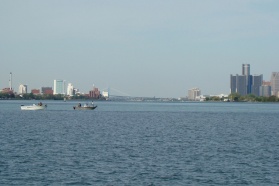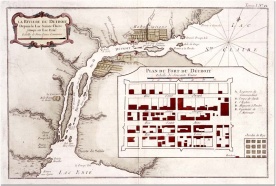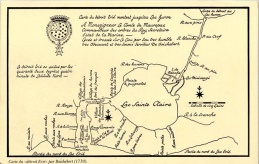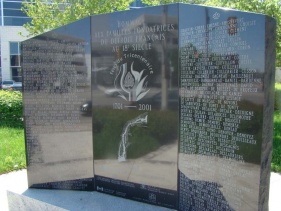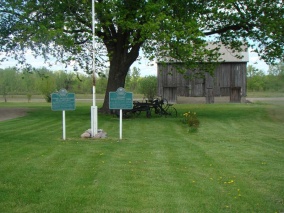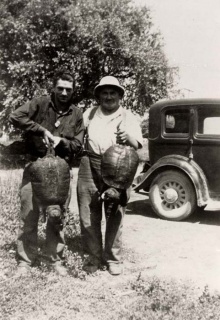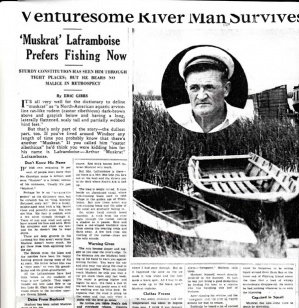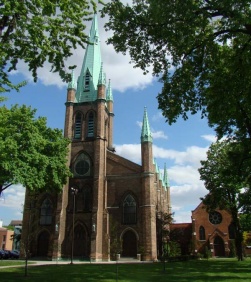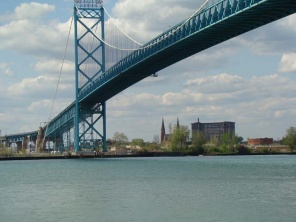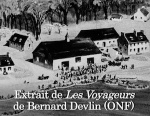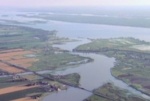Detroit River: A Special Place in French North American History
par Bénéteau, Marcel
In 2001, the Detroit River was added to the Canadian Heritage Rivers System. This honor came after its nomination the previous year as a natural heritage site by the United States government. In fact, it is the only river in North America to be designated by both countries as such. The Detroit River is the site of the oldest enduring European settlement in North America. It is also the home of the first permanent French-speaking community west of Montreal. Members of this community celebrated the 300th anniversary of the Detroit/Windsor region in 2001. The slogan of the celebrations was "Returning to our roots - Shining a light on our future!" French-speaking people of the region have a common objective: to have the area recognised as an important piece of French history in North America. The Detroit River is an important symbol that creates a sense of belonging for French speakers of the region, just as the Saint-Lawrence River is an important symbol for the French Canadians of Quebec.
Article disponible en français : Rivière Détroit comme lieu de mémoire francophone
Detroit River, a Passage between the Lakes
The Detroit River, which connects Lake Erie and Lake Saint Clair to Lake Huron, now serves as an international border between the cities of Windsor, Ontario and Detroit, Michigan. The River played an important role in the history of both countries. Over the years, it hosted numerous different cultural groups that made contributions to the development of Canada and the United States. Located in the heart of North America, the Detroit region was an important place of passage and a meeting point for many different groups including Natives and Europeans, French and English, Canadians and Americans. The fur trade, the Pontiac Rebellion, the War of 1812, the Underground Railroad, the 1837 Rebellion, and Prohibition of the 1920s are only a few of the events that marked the rich history of the area. The region was also one the first to be industrialised and to develop workers' unions in the 20th century. The development of the region thus illustrates the transition from tradition to modernity in Canada. The 300-year old presence of the French language on the Canadian side of the river is a factor that distinguishes this region from all others in North America.
French Canadians of the Detroit River
Founded by the French in 1701, the purpose of the Detroit colony was to reinforce French presence in the great lakes region (also known as Pays d'en Haut), which was a very important region in the fur trade. Antoine Laumet (known as Lamothe-Cadillac) established Fort Pont chartrain on the north shore of the river (now on the American side). Despite difficult beginnings, a French population was established and the colony became an important supply centre for the entire great lakes region. In 1749, the governor of New France granted the first territory on the south shore of the river (now on the Canadian side). The new settlement at Petite Côte, a few kilometres downstream from Fort Pontchartrain, was the first permanent European settlement in what isnow the province of Ontario. The region did not remain under French control for long. In 1760, both the north and south shores were controlled by the English.The English subsequently had to give up control of the north shore to the Americans in 1796 when the river was declared the border between Upper Canada and Michigan. At that time, French Canadians occupied the majority of the land on both shores of the river, from Lake Saint Clair to Lake Erie (NOTE 1). After the War of 1812, massive immigration from Kentucky and New England and the British Isles changed the landscape, putting French Canadians in a minority situation. On the American side, the French-speaking population gradually disappeared. However, on th eCanadian side, a French-speaking minority population continues to exist even to this day. This is, in part, thanks to a wave of immigrants from the Saint-Lawrence Valley in the second half of the 19th century.
French Cultural Heritage in the Detroit-Windsor Region
Both shores of the river underwent major changes during the 20th century. Industrial and urban development as well as demographic changes to the region overshadowed most visible signs of the French heritage. Nonetheless, the passing of the first European settlers left an enduring mark on the landscape and culture however subtle it may now appear. This article briefly describes the influence of the first French settlers on the landscape of the region. It takes a brief look at how they shaped the land through resource exploitation such as farming and fishing. It also looks at the heritage that these people left behind. In another article on the Detroit region, we discuss the heritage as related to language and oral traditions.
In his book Toponymie Française de l'Ontario, André Lapierre presents a list of names of places, of islands and of bodies of water that were named by the first French Settlers (NOTE 2). Despite the fact that most of the names are now in English on official maps in Canada and the United States, the French designations are still used by French speakers in the region. Older people in the area still call the river, the Rivière du Détroit. A string of islands scattered across the river have also retained their French names though slightly anglicised in most cases (i.e., Île à la Pêche [Peach Island], Île aux Dindes [Turkey Island], Grosse Île [same in English], Île aux Bois-Blancs [Bob-lo Island]). The same is true for the rivers that flow into the Detroit River from either side of the border Petite Rivière [Little River], Rivière-aux-Dindes [Turkey Creek], Rivière-aux-Canards [River Canard], Rivière Rouge [River Rouge], Rivière-aux-Raisins [River Raisin]). Certain places have maintained their original French names used even by English speakers (e.g., Pointe Mouillée and Grosse Pointe, U.S.A. and Pointe Pelée, Canada). Inland from the river, many towns have maintained their French names used by the locals (e.g., Puce, Belle-Rivière, Saint-Joachin, Pointe-aux-Roches, Pain Court, Grande-Pointe, Petite Côte, Rivière-aux-Canards and LaSalle.)
Changing the Landscape and Exploiting Resources
The landscape was also shaped by French presence in the region. The locations of the two main cities of the regions, Detroit and Windsor, were a direct result of French settlement. For example, downtow nDetroit is located on the site the old Fort Pontchartrain. Windsor was built around the quay used by François Baby's ferry. The Windsor area is the only region in Ontario to be measured and plotted using a French method of surveying. Hence, the plots of land are typical of the French regime (i.e., long narrow strips of land with one edge on the riverbank). Many streets are also named after the first French settlers (e.g., Langlois, Marentette, Janisse, Parent, Pilette, Drouillard, St-Louis, Goyeau, Lespérance, Lauzon, Ouellette).
This particular method of plotting the land was an important factor in the economic development of the town of Petite-Côte. The town quickly became a major centre for farm produce though the first settlers were more involved in the fur trade than in agriculture. However, small scale farming that did not require clearing large lots of land soon became a way of life. In fact, the type of farming that was done allowed settlers to dedicate their time to hunting and trapping during the winter. The region's mild climate and its proximity to the Detroit market also favoured the development of farming in the town. Before globalisation of food markets, radishes from Petite Côte were the first vegetables on the Canadian market every year. Because of their timeliness and quality they were also sold as far away as Toronto and New York. In the years that followed, residential development and globalisation of food markets was much to blame for a reduction in agricultural activity. Nonetheless, there are still a few families in Petite Côte (now called LaSalle) that work the same strips of land as their ancestors did in the 18th century. The Detroit colony was also well-known for the quality of its orchards. The mild climate was favourable for growing apples, cherries, pears, peaches, and quinces. The French speakers of the region are known to have developed several varieties of apples (NOTE 3). They are also responsible for the well-known Jesuit pear trees, which is the subject of another article available on this site.
Hunting, trapping, and fishing were traditional activitiesof the French community in the region. Even in the 20th century, many families would generate supplementary income as a result of their trapping activities. A small street in Detroit is named Trapper's Alley in memory of th efur trade merchants that lived in the area. In Monroe, Michigan, (site of the old Rivière-aux-Raisins settlement) descendants of French settlers still call themselves Muskrat French, in memory of their ancestors who trapped muskrats. Muskrat French is also the term used to designate the French dialect used on both sides of the river.
Fishing was also a tradition for the French in the Detroit river region. Some inhabitants of Petite Côte still practice a form of spear fishing, which is said to have been learned from the natives (NOTE 4). Commercial fishing using seines (a type of large fishing net) became common practice before the end of the 18th century. Bela Hubbard (NOTE 5)describes the capstans and fishing huts that sprinkled the landscape at that time. According to W.H. Smith, fishing that was done in the fall gradually replaced fur trading as a source of income for the region's French speakers (NOTE 6). Île à la Pêche got its name because of the fish [processing] plants that were built there. (Note that la Pêche can be translated as fishing or peach, hence the English name Peach Island)
The time of Prohibition in the United States was an exciting period that proved to be a good business opportunity for some. In fact, many French speakers helped with smuggling alcohol across the border. According to oral tradition, the legendary "bootleggers" would unload their cargo in the canals and creeks around the river. They would drive model T Fords across the ice in the wintertime. Sometimes, they would hide contraband in crates of tomatoes destined for the Detroit market. Several popular books celebrate the exploits of bootleggers like Vital Benoit and Jonny Diesbourg and the brothers Athur "Muskrat" and "Whiskey" Jack Laframboise (NOTE 7). The community of LaSalle was incorporated in 1925 so the new town could obtain a customs office. This facilitated the exportation of merchandise to "Cuba". In reality, however, merchandise was often destined for the American market. The construction of the Sacré Coeur church in LaSalle was made possible thanks to donations made by the bootleggers.
An Important Piece of Heritage
The Detroit-Windsor area underwent several waves of industrial and residential expansion in the 20th century. As a consequence, French heritage was often neglected to make way for economic development which required new construction. As a result, examples of French architecture are rare. However, certain significant locations still exist. Karen Stopskopf-Harding mentions five important sites in her book Architecture Française en Ontario (NOTE 8). Among the sites mentioned are the Assumption Church, the house of François Baby, and the Duff-Baby house. None of these buildings date back to the French regime, but were nonetheless influenced by French architecture. The Assumption Church, built in Windsor from 1835 to 1845, is in fact the fourth church constructed on the site. The land was initially given the Huron people in 1748 in order to build a mission. The site became the location of the Paroisse de l'Assomption [Assumption Parish] in 1767, which is the oldest parish in Ontario.
Many other pieces of French heritage were inventoried in 1991 and 1992 during the Inventaire du Patrimoine Franco-Ontarien (IPFO). Serge Saint-Pierre discusses some beautiful examples of French religious, residential, institutional and agricultural architecture in Habiter le Pays [Life in the Region], a book written for the Centre Franco-Ontarien de Folklore. On the American side of the river, a notable example of French architecture is the Saint-Anne Church in Detroit. Built in 1895, this building is the fifth church of the parish, which dates back to when Cadillac founded Detroit. Though it is now a Hispanic parish, several French-era aspects of the building still remain. Its location, directly across from the Assumption Church in Windsor, is a reminder of the French presence, with both buildings overlooking the river from opposite sides.
Place of Historical Importance for Franco-Ontarians
The French left their mark on the Detroit River and the surrounding area. In order to appreciate the deep roots of the French people in the heart of North America, French speakers in southwest Ontario launched a large project in 2001, the 300th anniversary celebrations of the Windsor-Detroit region. The celebrations included family reunions, literary contests and an international conference. They also included a pontifical mass at the Assumption Church and a large concert at Windsor's Dieppe Park on the shores of the Detroit River. The fact that a French presence still exists in the industrial heart of North America is a source of pride for residents of the area. The goal of the celebrations was to celebrate 300 years of European presence in the region and acknowledge the survival of the area's French heritage-which is rather unique in North America. The rate of cultural assimilation of French speakers in the area is the highest in the entire province o fOntario. However, the 300-year French presence in the region constitutes a great source of pride that helps the community to stand strong in order to protect their language and culture.
Marcel Bénéteau
Department of folklore and ethnology of French America
University of Sudbury, Ontario
NOTES
Note 1. The book by E.J. Lajeunesse, The Windsor Border Region, is still the best introduction to the first century of French presence in the region.
Note 2. André Lapierre, Toponymie française en Ontario, Montréal, 1981.
Note 3. Silas Farmer, History of Detroit and Wayne County and Early Michigan, Détroit, 1890; réimpression de la Gale Research Company, Détroit, 1969, p. 13.
Note 4. Marcel Bénéteau, « Vers l'an 2001 », chronique radiophonique diffusée par CBEF, Radio-Canada Windsor, de septembre 1996-juin 1997; no 18.
Note 5. Bela Hubbard, Memorials of a Half-Century, New York et London, G.P. Putnam's Sons, 1887, p.142.
Note 6. W. H. Smith, Canada : Past, Present and Future. Being a Historical, Geographical, Geological and Statistical Account of Canada West, vol. I, Toronto, Thomas Maclear, 1951.
Note 7. See, amongst others, C. H. Gervais, Rumrunners : a Prohibition Scrapbook, Thornhill, Firefly Books, 1980 et le roman de Paul-François Sylvestre, Des œufs frappés, Sudbury, Prise de Parole, 1986.
Note 8. Karen Stoskopf-Harding, Architecture française en Ontario. Quatre exemples marquants de l'œuvre de nos premiers bâtisseurs, Ottawa et Sudbury, Prise de Parole, 1987, 107 p.
BIBLIOGRAPHY
Bénéteau, Marcel (dir.), Le Passage du Détroit. 300 ans de présence francophone/Passages : Three Centuries of Francophone Presence at Le Détroit, Windsor, The Humanties Research Group, Working Papers in the Humanties 11, 2003, 348 p.
Dunnigan, Brian Leigh, Frontier Metropolis. Picturing Early Detroit, 1701-1838, Détroit, Wayne State University Press, 2001, 248 p.; cartes et illustrations.
Farmer, Silas, History of Detroit and Wayne County and Early Michigan, Détroit, 1890; réimpression de la Gale Research Company, Détroit, 1969, p. 13.
Lajeunesse ,Ernest J., The Windsor Border Region : Canada's Southernmost Frontier. A Collection of Documents, Toronto, The Champlain Society et University of Toronto Press, 1960, cxxix-374 ps.
Paré, Georges, The Catholic Church in Detroit, 1701-1888, Détroit, Wayne State University Press, 1951, 717 p.
Saint-Pierre, Télesphore, Histoire des Canadiens français du Michigan et du comté d'Essex, Ontario, Sillery (Québec), Septentrion, 1895, 335 p.
Stoskopf-Harding, Karen, Architecture française en Ontario. Quatre exemples marquants de l'œuvre de nos premiers bâtisseurs, Ottawa et Sudbury, Prise de Parole, 1987, 107 p.
Toupin, Robert, Les Écrits de Pierre Potier, Ottawa, Les Presses de l'Université d'Ottawa, 1996, 1329 p.
Additional DocumentsSome documents require an additional plugin to be consulted
Images
-
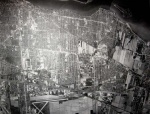 14. Photo aérienne de
14. Photo aérienne de
Windsor montra... -
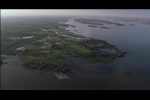 Embouchure de la rivi
Embouchure de la rivi
ère, près du la... -
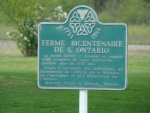 Ferme Pajot, plaque c
Ferme Pajot, plaque c
ommémorative -
 Monument au chemin de
Monument au chemin de
fer clandestin...
-
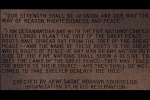 Plaque commémorative
Plaque commémorative
-
 Plaque commémorative
Plaque commémorative
du chemin de fe... -
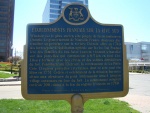 Plaque historique, Pa
Plaque historique, Pa
rc Dieppe au bo... -
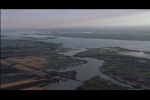 Vue aérienne de la ri
Vue aérienne de la ri
vière Détroit...
-
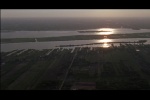 Vue aérienne de la ri
Vue aérienne de la ri
vière Détroit... -
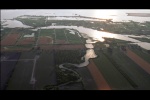 Vue aérienne des terr
Vue aérienne des terr
es -
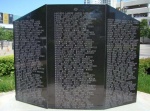 Vue arrière du mur de
Vue arrière du mur de
s noms -
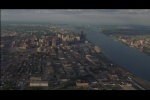 Vue de Detroit
Vue de Detroit
Vidéos
Hyperliens
- The Canadian Heritage River System
- Ameirican Heritage Rivers
- Welcome to Windsor: The Survival of a French Culture

